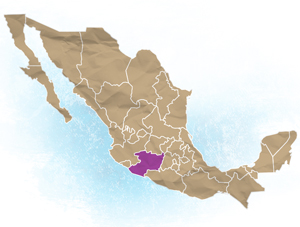Michoacan
Discover the land of the Ancient & Present Day Purepecha People.
Known for its natural beauty and colonial charm, Michoacan is a gem waiting to be discovered. The vast and diverse landscape ranges from coastal lowlands, to peaks of over 10,000 feet. In 1943, the great peak of Paricutin blew its top and today one can see the remains of the Tarascan village of San Juan that lied in its shadows. Unlike Pompeii, however, the townspeople knew the eruption was imminent and fled to their safety. Lake Patzcuaro and the small island of Janitzio provide stunning panoramas. Michoacan is also known for its famous Cocucho pottery and the Dance of “Viejitos”!
Tours in Michoacan:
Join us on a journey to learn about and witness one of nature’s wonders–the monarch butterfly migration. Here, in the fir trees of Michoacan at between 8,000-12,000 feet, the monarch butterflies take rest for the winter months after flying over 3,000 miles. Here, they cluster in groups on the fir trees to stay warm. During the day, they enjoy the sunshine and can be seen flying in massive groups…
If you love textile traditions, dye resist techniques and colonial cities, this trip is for you! This year, our trip is scheduled around the Feria del Rebozo in Tenancingo. We enjoy this unique opportunity to see (& buy) the “best from the best” for our special collections. In Mexico City, we’ll visit the shrine of “Nuestor Senor del Rebozo”, and see the Franz Mayer Museum antique rebozo collection…
This is why we love Michoacan:
The Capital City of Morelia, a Colonial gem and center for Education, Art & Music.
The Lakeshore Town of Patzcuaro, known for its plazas, cobblestone streets & craft traditions.
The communities on the shores of Lake Patzcuaro such as, Tzintzuntzan, Santa Fe de la Laguna.
The craft traditions in pottery, fiber arts, textiles and copper; dating back to the early colonial period
and the work of Bishop Vazco de Quiroga.
The Ancient Purepecha Ruins of Tzintzuntzan, “Place of the Hummingbirds”. Here, the Purepecha
people evaded the incursions of the Aztecs.
The high tropical plateau, or Meseta Purepecha, this is the avocado growing capital of Mexico.
The Day of the Dead Festival and Traditions are singular in Michoacan.
It’s so nice in Michoacan, even the Monarch Butterflies like to spend their winters here!.
Monarch Butterfly Migration
Unlike most other insects in temperate climates, Monarch butterflies cannot survive a long cold winter. Instead, they spend the winter in roosting spots. Monarchs east of the Rocky Mountains fly south to the forests high in the mountains of Mexico. In all the world, no butterflies migrate like the Monarchs of North America. They travel much farther than all other tropical butterflies, up to three thousand miles. They are the only butterflies to make such a long, two way migration every year. Amazingly, they fly in masses to the same winter roosts, often to the exact same trees. Their migration is more the type we expect from birds or whales.

However, unlike birds and whales, individuals only make the round-trip once. It is their children’s grandchildren that return south the following fall. As they migrate southwards, Monarchs stop to nectar, and they actually gain weight during the trip! Some researchers think that Monarchs conserve their “fuel” in flight by gliding on air currents as they travel south. This is an area of great interest for researchers; there are many unanswered questions about how these small organisms are able to travel so far. Another unsolved mystery is how Monarchs find the overwintering sites each year. Somehow they know their way, even though the butterflies returning to Mexico or California each fall are the great-great-grandchildren of the butterflies that left the previous spring. No one knows exactly how their homing system works; it is another of the many unanswered questions in the butterfly world.
Dia de Muertos
“Day of the Dead in Mexico represents a mixture of Christian devotion and Pre-Hispanic traditions and beliefs. As a result of this mixture, the celebration comes to life as an unique Mexican tradition including an altar and offerings dedicated to the deceased. The altar includes four main elements of nature — earth, wind, water, and fire. Earth is represented by crop: The Mexicans believe the souls are fed by the aroma of food. Wind is represented by a moving object: Tissue paper is commonly used to represent wind. Water is placed in a container for the soul to quench its thirst after the long journey to the altar. Fire is represented by a wax candle: Each lit candle represents a soul, and an extra one is placed for the forgotten soul.” -Mary J. Andrade, from Through the Eyes of the Soul, Day of the Dead in Michoacan

Photos From These Trips












